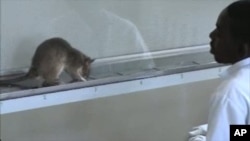Scientists say they've found a method for detecting tuberculosis: an African rat. Researchers say the sniffing powers of the African pouched rat can help detect TB in sputum samples more efficiently and at a lower cost than lab technicians using microscopes.
Researchers at a non-profit medical research facility in Tanzania, called APOPO had a hunch about the African pouched rat.
Knowing that the rodent has a keen sense of smell, APOPO researchers wondered if they could train the rats to detect the odor of the tuberculosis bacterium in infected samples of human sputum.
The rodent, which weighs about a kilogram and gets its name from giant cheek pouches it stuffs full of food, is native to sub-Saharan Africa, where the tuberculosis infection rate is the highest in the world.
Investigators conducted a head-to-head comparison of the rats' ability to smell tuberculosis against the skills of laboratory technicians testing more than 10,500 sputum samples gathered from patients from five TB treatment centers in Tanzania.
Using conventional microscopic analysis, technicians found that just over 13 percent of the sputum samples were positive for tuberculosis.
The same samples were then analyzed by a group of 10 rats in a special sniffer cage, and the second-line screening by the animals picked up an additional 620 new TB-positive patients, a 44 percent increase over the tuberculosis detection rate by technicians. Alan Poling, a psychologist at Western Michigan University in Kalamazoo, led the study.
Poling is not prepared at this point to say that the pouched rats are better at detecting TB than trained technicians using microscopes. But he says the animals are a lot quicker.
"They can test hundreds of samples a day," said Poling. "And we essentially get results immediately. A microscopist can do 20 to 40 samples a day, so it's very slow for microscopists. It's also not very accurate. They miss a lot of positivies."
The rats work in a long, narrow stainless steel cage with ten small wells, or holes set into the floor. Each hole contains a sputum sample. The animals walk the length of the cage, sniffing each hole.
They have been trained to stop and linger at a hole if it contains a sputum sample that is TB-positive. If the rodents stop for at least five seconds at a hole, they are rewarded with a treat, according to Poling, who says the rats are tireless workers.
"They work for bananas. They love bananas. So, they'll work endlessly for a mouthful of banana," added Poling.
The best diagnostic test for tuberculosis is to culture a sputum sample to check for the presence of growing bacteria. But that process can take weeks because the tuberculosis bacterium grows very slowly.
Health experts are not sure about the value of recruiting rats in the global campaign against TB. Peter Hotez, president of the American Society of Tropical Medicine and Hygiene in Washington, says using rats to detect TB is fine, but other methods may be needed.
"I don't know if this giant rat approach - pouched rats - is going to be the be all and end all of detecting tuberculosis," said Hotez. "I think we can do even better than that in terms of a test that is widely applicable. But it points out the importance of being innovative and trying to maximize our approaches."
If it turns out that the pouched rats are more accurate for first line detection of tuberculosis than laboratory microscopy, investigator Alan Poling of Western Michigan University envisions taking the rats to remote areas to diagnose TB.
A study of the use of giant African rats to detect tuberculosis in lab samples is published in the December issue of the American Journal of Tropical Medicine and Hygiene. TB accounts for 3 million deaths annually.
